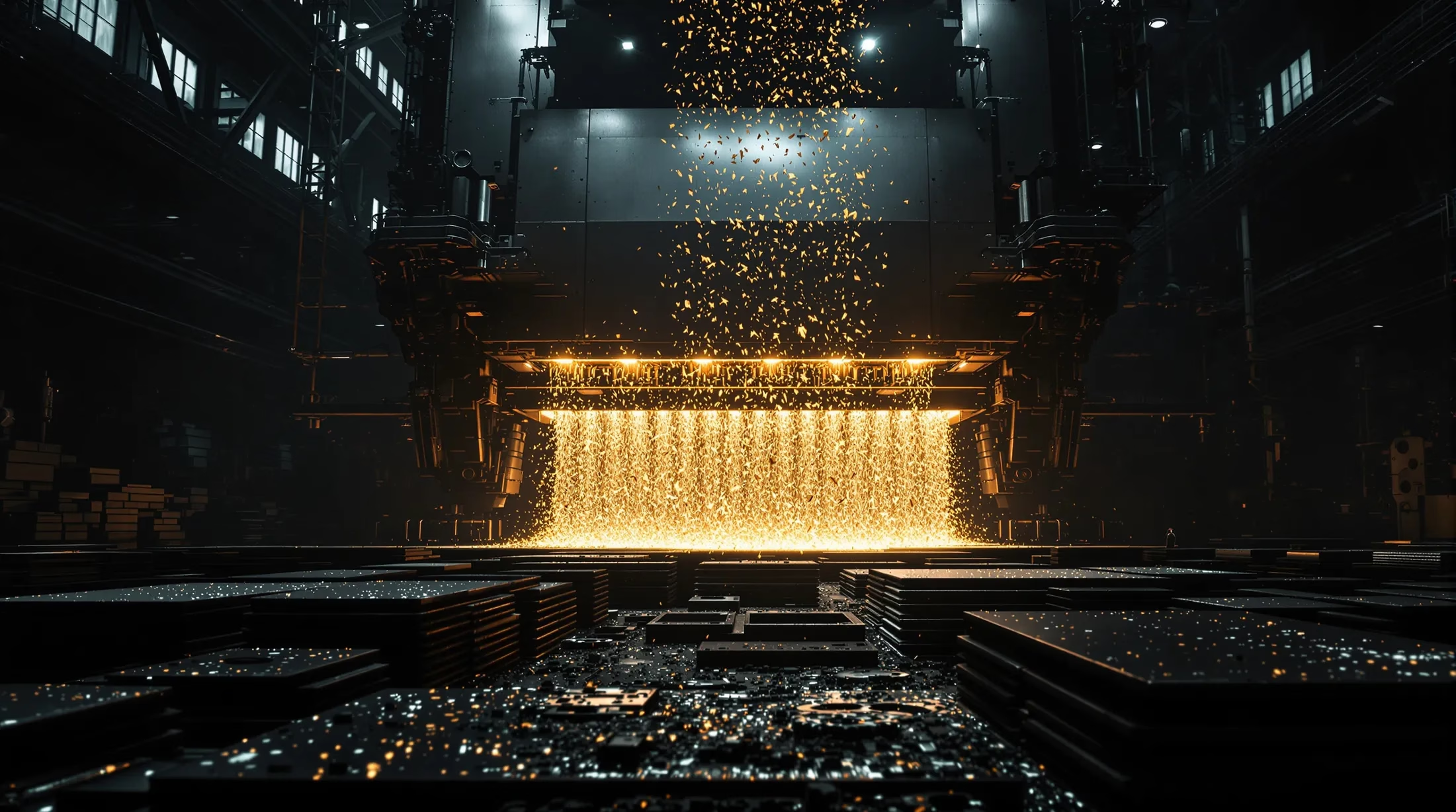Metal Stamping: A Comprehensive Guide to Techniques and Applications
Discover the transformative power of metal stamping – a manufacturing process that’s revolutionizing how we create precision metal components. From automotive parts to everyday items, this versatile technique combines efficiency with unmatched accuracy to meet modern manufacturing demands.
Understanding Metal Stamping
Metal stamping transforms flat sheet metal into precisely shaped components through controlled force and specialized tooling. This cold-working technique processes metal sheets, available in coil or blank form, into specific, preset forms using stamping presses. The process delivers exceptional efficiency and precision, making it ideal for high-volume production across diverse industries.
Unlike traditional metal forming methods, stamping creates components with remarkable consistency. Through strategically configured dies and punches, manufacturers can execute complex operations while maintaining tight specifications and minimizing material waste.
What is Metal Stamping?
At its core, metal stamping converts flat metal sheets into specific shapes using pressure-driven tools and dies. The process involves placing sheet metal into a stamping press where specialized tooling applies force to cut and form the material. This cold-working technique achieves deformation and shaping without heating the metal.
- Creates intricate parts with high repeatability
- Performs multiple operations in a single press stroke
- Maintains tight tolerances consistently
- Maximizes production efficiency
- Suitable for high-volume manufacturing
History and Evolution of Metal Stamping
Metal stamping’s journey began during the Industrial Revolution, though its fundamental principles trace back to ancient metalworking. The introduction of mechanical presses in the 19th century marked a pivotal advancement, enabling consistent force application for precise metal forming.
| Era | Key Developments |
|---|---|
| 19th Century | Introduction of mechanical presses |
| 20th Century Early | Hydraulic and pneumatic systems implementation |
| 20th Century Late | Integration of computerized controls and automation |
| Present Day | Advanced materials science, digital simulation, robotic automation |
Techniques in Metal Stamping
Metal stamping encompasses various specialized techniques that transform flat metal sheets into complex, functional components. Modern facilities employ sophisticated combinations of these methods, integrating multiple processes into streamlined production systems.
Progressive Stamping
Progressive stamping represents the pinnacle of efficient metal forming. This method utilizes a specialized die set with multiple stations, each performing specific operations as metal advances through the press. The material feeds continuously from a coil, moving through successive stations where operations build upon previous steps.
- Production rates exceeding hundreds of parts per minute
- Exceptional speed and repeatability
- Lower labor costs and reduced material waste
- Superior quality control capabilities
- Ideal for medium to high-volume production
Deep Drawing and Other Techniques
Deep drawing creates hollow, three-dimensional shapes from flat sheet metal, pulling material into a forming die using a punch. This technique produces components with depth greater than their diameter, requiring precise control of material properties and process parameters.
- Fourslide stamping – complex bending from multiple directions
- Blanking – precise cutouts from sheet metal
- Coining – detailed surface features and precise dimensions
- Embossing – raised or recessed designs
- Flanging – edge and rim formation
- Shearing – clean cutting without chips
- Piercing – precise hole creation
Materials Used in Metal Stamping
Metal stamping processes accommodate a wide range of materials, each selected based on specific metallurgical properties and end-application requirements. The versatility of stamping technology enables manufacturers to work with both common base metals and specialized alloys, offering exceptional flexibility in meeting diverse industry demands.
Material selection directly influences stamping process parameters, including press tonnage requirements, tool wear rates, and achievable tolerances. Engineers evaluate several critical factors when choosing materials:
- Material ductility and formability
- Hardness specifications
- Tensile strength requirements
- Grain structure characteristics
- Cost considerations
- Production volume requirements
Common Materials for Stamping
| Material Type | Key Properties | Primary Applications |
|---|---|---|
| Steel (Various Grades) | Exceptional strength, formability, cost-effective | Automotive components, structural parts |
| Aluminum | Lightweight, corrosion-resistant, recyclable | Aerospace, automotive lightweight parts |
| Brass/Copper Alloys | Superior electrical conductivity, thermal properties | Electrical components, heat exchangers |
| Beryllium Copper | High strength, excellent conductivity | Aerospace, defense, electronics |
For beginners and prototype development, manufacturers often recommend starting with more forgiving metals like aluminum or pewter. These materials provide clearer impressions and reduce the likelihood of stamping errors. While sheet metal remains the primary material for stamping operations, the technology has evolved to accommodate specialized materials, including certain polymers for specific applications.
The Metal Stamping Process
Metal stamping represents a sophisticated cold-working manufacturing process that transforms flat sheet metal into precise, predetermined shapes. This highly efficient method utilizes stamping presses to perform multiple operations, including cutting, bending, and shaping, delivering components that meet exact specifications with remarkable consistency.
Step-by-Step Stamping Process
- Pre-production planning and design specification development
- Tool design and manufacturing with stock strip layout optimization
- Material feed setup and automation system configuration
- Sequential operations execution:
- Blanking – initial shape cutting
- Piercing – hole creation
- Forming – bending and shaping
- Drawing – depth creation
- Finishing operations
- Quality control inspections at predetermined intervals
- Automated part removal and secondary operations as required
Advantages of Metal Stamping
Metal stamping delivers exceptional manufacturing capabilities and economic benefits through its high-volume production capacity and precision. A well-optimized stamping operation can produce thousands of identical components hourly while maintaining strict quality standards.
- Superior production rates compared to alternative forming methods
- Lower per-unit costs at high volumes
- Exceptional design flexibility for complex geometries
- High material utilization rates
- Advanced automation capabilities
- Consistent quality across production runs
- Reduced need for secondary operations
Applications of Metal Stamping
Metal stamping has established itself as a fundamental manufacturing process across diverse industrial sectors, combining versatility, precision, and cost-effectiveness at scale. This technology delivers complex components with high dimensional accuracy and consistent quality at remarkable speeds, making it indispensable in modern manufacturing. From safety-critical transportation components to intricate consumer electronics parts, stamped metal components are essential in countless everyday products.
The process’s adaptability to various materials – including steel, aluminum, copper, brass, and specialized alloys – expands its application potential significantly. Metal stamping accommodates requirements ranging from lightweight components with complex geometries to heavy-duty structural elements requiring exceptional strength characteristics. As industry demands evolve toward lighter, stronger, and more sustainable products, metal stamping technologies continue advancing through innovations in tooling design, process automation, and material optimization.
Industry Applications
| Industry | Key Applications | Specific Requirements |
|---|---|---|
| Automotive | Body panels, chassis parts, brackets | High-strength steels, lightweight alloys |
| Aerospace | Aircraft frames, engine components | Weight reduction, absolute reliability |
| Electronics | Connectors, terminals, shields | Precision, conductivity |
| Medical | Surgical instruments, implantable devices | Sanitary conditions, high precision |
Design Considerations in Metal Stamping
Successful metal stamping depends on thoughtful design considerations that balance functionality, manufacturability, and cost-efficiency. Engineers must evaluate multiple factors when developing stamped components:
- Material properties and behavior during forming
- Part geometry optimization
- Tooling requirements and limitations
- Production volume expectations
- Cost-efficiency measures
- Quality control parameters
Tooling and Tolerances
Tooling design fundamentally influences part quality, production speed, and manufacturing costs. High-quality stamping tools utilize premium tool steels with specialized heat treatments for high-volume production durability. Different die types offer distinct advantages:
- Progressive dies – optimal for high-volume sequential operations
- Compound dies – efficient for complex single-station operations
- Transfer dies – suitable for large or complex parts
Standard industry tolerances typically range from ±0.005″ to ±0.010″ (0.127mm to 0.254mm). Key design principles include maintaining minimum corner radii of half the material thickness, ensuring hole-to-bend clearances of 1.5 times material thickness, and designing notches and tabs with widths at least 1.5 times the material thickness. These guidelines optimize manufacturing efficiency while ensuring consistent quality.
Cost Factors in Metal Stamping
Metal stamping operations encompass multiple interrelated cost factors that require careful evaluation during production planning. The initial tooling investment represents a substantial expense, with complex progressive dies potentially reaching tens of thousands of dollars. However, this upfront cost becomes increasingly economical when amortized across larger production volumes. For runs exceeding 10,000 parts, stamping typically delivers the lowest per-unit cost compared to alternative metal forming methods.
- Material selection – impacts production costs and product performance
- Labor requirements – vary based on automation level
- Secondary operations – finishing, deburring, and plating
- Quality control procedures – inspection and testing
- Maintenance requirements – regular tooling upkeep
- Production run length – affects cost amortization
Quality Control in Metal Stamping
Quality control forms the backbone of successful metal stamping operations, ensuring consistent compliance with design specifications and performance requirements. Modern stamping facilities implement comprehensive inspection protocols from material verification through final validation, creating a robust quality management framework.
- Vision systems with high-resolution cameras for surface inspection
- Coordinate measuring machines (CMMs) for dimensional verification
- Statistical Process Control (SPC) for variation monitoring
- Automated inspection systems for critical applications
- Data analysis tools for trend identification
Quality Inspection Methods
| Method | Application | Benefits |
|---|---|---|
| First-article inspection | Initial production validation | Comprehensive verification before full production |
| In-line inspection | Continuous monitoring | Real-time quality assurance |
| Ultrasonic testing | Internal defect detection | Non-destructive evaluation |
| X-ray inspection | Complex component analysis | Internal structure visualization |
Common Defects and Prevention
- Material thinning and stretching – optimize blank holder pressure and draw beads
- Springback – implement overbending and design compensation
- Surface imperfections – select appropriate die materials and treatments
- Burrs – maintain optimal punch-to-die clearances
- Dimensional variations – verify incoming materials and maintain tools
Effective defect prevention combines technological solutions with comprehensive operator training and standardized procedures. Tool optimization software enables manufacturers to simulate operations and predict potential issues before production begins, while systematic maintenance schedules help extend tool life and maintain consistent quality.
Recent Advancements in Metal Stamping
The metal stamping industry has experienced remarkable technological transformation through automation and advanced control systems. Computer Numerical Control (CNC) stamping technology has revolutionized production capabilities, achieving tolerances of ±0.0005 inches (0.0127mm) – essential for micro-precision components in medical devices and electronics.
- AI and machine learning systems predict tool wear and optimize production parameters
- Servo-driven presses offer programmable stroke control with 30% improved energy efficiency
- Industry 4.0 integration enables predictive maintenance, reducing downtime by 45%
- High-speed systems achieve up to 1,500 strokes per minute
- Intelligent nesting algorithms improve material utilization by 15-20%
Automation and Robotics
Modern metal stamping facilities have transformed through comprehensive robotics integration, creating highly efficient production environments. Automated systems manage everything from coil loading to finished product packaging, delivering 200-300% productivity increases compared to manual operations.
- Vision-guided robots ensure submillimeter accuracy
- Collaborative robots (cobots) work safely alongside operators
- Force-limiting sensors provide immediate operational halts
- Modular systems offer accessibility for small manufacturers
- ROI typically achieved within 18-24 months
Digital Simulation and Process Optimization
Advanced Finite Element Analysis (FEA) software has revolutionized metal stamping through virtual testing and optimization. These digital tools predict material behavior with exceptional accuracy, considering multiple variables simultaneously for comprehensive process validation.
| Digital Innovation | Impact |
|---|---|
| Digital prototyping | 40% reduction in tooling development costs |
| Time-to-market improvement | 30-50% faster for complex components |
| Digital twin integration | Real-time process optimization |
| Machine learning analysis | 5-15% increase in yield rates |
Environmental and Sustainability Considerations
The metal stamping industry has embraced comprehensive sustainability initiatives to address environmental concerns while maintaining production efficiency. Modern manufacturers implement various eco-friendly solutions that significantly reduce their environmental footprint.
- Energy-efficient equipment upgrades reducing power consumption by 20-40%
- Closed-loop fluid recycling systems minimizing water usage
- Advanced scrap management achieving 95% recycling rates
- High-strength materials enabling thinner gauge components
- Biodegradable lubricants replacing petroleum-based products
- Lean manufacturing principles minimizing production waste
Waste Reduction Strategies
Advanced nesting software has revolutionized material utilization in metal stamping operations, achieving up to 30% reduction in scrap rates compared to traditional methods. These sophisticated algorithms analyze multiple variables simultaneously – part geometry, grain direction, and material properties – to optimize sheet or coil layout patterns. Progressive die designs enhance efficiency through features like common line cutting, eliminating narrow scrap strips between components.
- Comprehensive waste management hierarchies prioritizing reduction, reuse, and recycling
- Metal scrap segregation systems maintaining material purity
- Automated scrap handling equipment improving workplace safety
- Industrial symbiosis relationships converting waste into raw materials
- Closed-loop cooling systems with advanced filtration technology
- Process water reuse systems reducing consumption and discharge
Energy Efficiency Improvements
Modern metal stamping facilities have achieved significant energy efficiency gains through strategic equipment upgrades and management systems. Servo-electric presses have emerged as game-changers, delivering up to 70% reduction in energy consumption while providing superior precision and control.
| Energy Initiative | Impact |
|---|---|
| Servo-electric press systems | 70% energy reduction |
| Smart lighting controls | 50-80% lighting efficiency improvement |
| Heat recovery systems | Waste heat repurposing for facility needs |
| Renewable energy integration | 2-3 year payback period |
Challenges and Solutions in Metal Stamping
Material springback presents a significant challenge in metal stamping, particularly with high-strength materials. Engineers address this through compensatory die designs and sophisticated finite element analysis. Die wear management involves advanced tool steel selection and specialized heat treatments, extending die life by 200-300%.
- Variable binder pressure systems for complex forming operations
- Strategic draw beads and pressure pads controlling material flow
- Heated dies for advanced high-strength steels (AHSS)
- Specialized warm forming processes enhancing formability
- Real-time monitoring systems with adaptive controls
- Automatic process parameter adjustment capabilities
Material Handling Challenges
Material handling represents a critical challenge in high-volume stamping operations, where efficiency and precision directly impact productivity. Traditional manual methods create bottlenecks, particularly with large or unwieldy materials. Modern facilities employ automated feeding systems that position materials within ±0.004 inches (0.1mm) tolerances, ensuring consistent part formation.
- Sophisticated destacking systems for blank separation without surface damage
- Servo-driven feeders advancing coiled material at 30+ strokes per minute
- Robotic transfer systems with specialized end-of-arm tooling
- Vacuum handling technology for delicate components
- Automated lubricant application systems
- Specialized cleaning stations for pre-welding or painting preparation
These advanced material handling solutions have demonstrated remarkable results, with facilities reporting up to 40% productivity improvements following comprehensive automation implementation.
Innovative Problem-Solving Approaches
| Solution | Impact |
|---|---|
| Design for Manufacturability (DFM) | Early issue identification and prevention |
| Virtual Manufacturing Simulation | 70% reduction in development time |
| Hybrid Manufacturing Approaches | Enhanced production capabilities |
| Statistical Process Control (SPC) | 80% defect rate reduction |
Future Trends in Metal Stamping
The metal stamping industry is undergoing significant transformation through emerging technologies and market demands. Advanced materials development leads this evolution, with high-strength alloys and composite metals enabling unprecedented part performance. Multi-material stamping techniques now combine different metals in single components, reducing weight by 20-30% compared to traditional designs.
- Industry 4.0 integration with comprehensive digitalization
- Smart factories generating terabytes of process data
- Predictive analytics for real-time quality monitoring
- Augmented reality for operator training (25-40% faster changeovers)
- Micro-stamping capabilities for miniaturized components
- Specialized processes for electric vehicle components
Sustainability-Driven Innovations
Environmental considerations are driving radical innovation in stamping processes. Near-net-shape forming techniques reduce material waste by up to 40%, while dry stamping technologies eliminate traditional lubricants. Next-generation servo presses with regenerative drives achieve 30-50% energy savings while providing enhanced precision and control. The industry’s commitment to sustainability is evident through comprehensive life cycle assessments and measurable climate initiative goals.
Customization and Flexibility
Market demands for product customization are transforming traditional stamping operations. The industry is shifting from high-volume, low-mix production toward flexible manufacturing systems that efficiently handle smaller, more diverse batches. Modern rapid die change systems achieve complete tooling transitions in under 10 minutes – a dramatic improvement from the hours required by conventional methods. Modular tooling solutions enhance adaptability by enabling quick reconfiguration for different part families without complete die replacements.
- Digital manufacturing platforms connecting designers directly with production capacity
- Cloud-based production planning and scheduling systems
- Integration of additive manufacturing with traditional stamping processes
- Hybrid manufacturing approaches combining multiple technologies
- Flexible production systems handling batch sizes of 50-100 units
- Real-time capacity optimization and allocation
Resources for Further Learning
| Resource Provider | Available Materials |
|---|---|
| ImpressArt | Comprehensive tutorials, Getting Started guides, hands-on workshop classes |
| Beaducation | Metal selection guides, measurement references, beginner’s checklists |
| Technical Resources | Measurement charts, metal property guides, specialized templates |
| Industry Associations (PMA/FMA) | Technical publications, standards, certification programs |
These educational resources provide comprehensive support for both beginners and experienced professionals in the metal stamping industry. The combination of theoretical knowledge and practical guidance enables practitioners to develop their skills systematically while staying current with industry developments and best practices.







